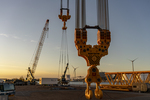News Release from American Clean Power Association (ACP)
Wind Industry Profile of
05/26/2017
Staying strong through the 2020’s: Policy trends
Policy trends
- State policies. Many states are considering increasing their renewable energy standards; states with over a quarter of the U.S. population have increased their goals since 2015. These laws will continue to drive wind purchases after national policy phases out. Researchers from top national laboratories find existing state RPS policies will create 4.7 million job years – one person working full-time for a year – and $258 billion in health and environmental benefits through 2050, typically at no net cost.
- Utility IRPs. Utilities in 33 states must file Integrated Resource Plans (IRPs) forecasting their electricity mix for five to 20 years. Wind’s low cost and fixed price make it an essential part of their planning. Its track record for reliability and grid services has led some utility executives to call wind “the new baseload.” Recently, utilities like PacifiCorp have announced IRP’s calling for massive amounts of new wind, while Warren Buffett’s MidAmerican Energy says it soon could be 90 percent wind-powered.
- Transmission buildout. Administration leaders, grid operators and our industry are pushing to upgrade grid infrastructure and get low-cost energy to market. Transmission pays for itself many times over in consumer savings, so obstacles are mainly policies and regulations, not dollars. The expected infrastructure bill in Congress presents an opportunity.
- Factory jobs. One of the Trump campaign’s top promises was keeping U.S. factory jobs. That helps voters who turned out in the election. The U.S. started 2017 with 25,000 wind-related jobs at over 500 factories. Navigant says that can grow by 8,000 during President Trump’s first term, totaling 33,000 by 2020. These jobs tend to be where they’re needed the most. Ohio leads with 62 wind-related factories, while Wisconsin and Pennsylvania have 26 each, and Michigan 25.
- Bipartisan support. Dozens of Republicans in both the House and Senate strongly support wind because they see its economic benefits back home. By 2020, Navigant projects 147,000 American wind workers, and another 101,000 spinoff jobs in surrounding communities. We’ll generate $85 billion in economic activity over this presidential administration – much of it in rural and Rust Belt areas critical to the next election.
Wind energy remains on track to reliably supply 10 percent of the country’s electricity by 2020. The 16 trends we’ve examined will help get us to 20 percent by 2030. Wind energy works for America today, tomorrow and far into the future.
- Source:
- AWEA
- Author:
- Tom Kiernan
- Keywords:
- wind industry, state policy, federal policy, wind growth









